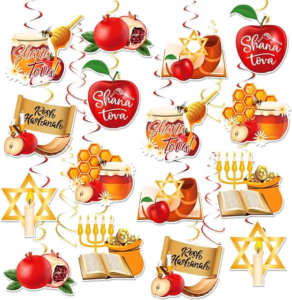
10 Rosh Hashanah/Yom Teruah Traditions for Christians

Celebrated by increasingly more Christians, Rosh Hashanah is based on a holiday commanded for God’s people in the Bible. Biblically called Yom Teruah, in Leviticus 23:23-25 and Numbers 29:1-6, God says it’s supposed to be a Sabbath and should be celebrated by blowing trumpets and offering sacrifices.
But how can we, as Christians, celebrate this Holy Day? Here are some ways to honor God in His command and bring the vital meaning of Rosh Hashanah and Yom Teruah into your Christian home and faith.
1. Read scripture
There are so many scriptures that relate to this Holy Day. It’s a day when we can be both thankful for the gift of forgiveness through Jesus and repentant of our sin. Some celebrate this as the day God created the universe. The story of Abraham being obedient in almost sacrificing his only son, Isaac, is often read. Here are some that I found inspiring and relevant to the concepts of Rosh Hashanah.
- Genesis 1:1-2:3 and 22
- Leviticus 23
- Psalm 32 and 139:23-24
- Micah 7:7-20
- Isaiah 53
- Jeremiah 31:27-40
- Matt. 26:26-29
- Luke 24
- Acts 2 and 3:19-21
- 1 Cor. 11:26
- 1 Thess. 4:13-18 and 5
- Hebrews 9
- James 5:7-11
- 1 John 1:5-10
- Rev. 22
2. Have a Tashlikh ceremony
From Micah 7:19, this is a Jewish custom symbolizing the “casting off” of our sins. Bread is thrown into running water. The bread symbolizes sin and is taken away and forgotten as our sin is when forgiven by God. As Christians, we can use this to remember that our sin has been paid for and removed by our Savior and Messiah as we confess it to him and put our faith in his ability to atone for it. My family has used oatmeal because it’s better for the animals that find and eat it, but some people use stones instead. It doesn’t matter what you use as long as it conveys the message that our sin can be cast off and forgiven if we accept the gift God gave us in Jesus.
3. Have a celebratory meal
While not required, as humans, we tend to celebrate with traditions concerning food. Dishes with apples are traditionally served during Rosh Hashanah, but any meal that everyone will love and come together over would work well. Here are a few ideas.
Slow Cooker Barbecue Brisket Sliders
Brisket is a traditional Jewish meal for almost any holiday. These sliders are super easy, and my family loves them. You could even serve them on your round challah bread (see below)!
This side dish is traditionally served on Rosh Hashanah. It’s a sweet baked mixture of carrots and sweet potatoes that will make your house smell delicious!
Kugel is a decadent Jewish dish that will surprise you if you haven’t tried it before. I was wary of putting noodles into a dessert, but it’s fantastic!
This bread is served at many Jewish celebrations and on the Sabbath. Usually a straight braided loaf, it’s made into a round shape on Rosh Hashanah to symbolize a crown, reminding us of God’s kingship over the universe. Here’s how to braid round challah.
Just something fun to put on your challah bread! Yum!
4. Blow a Shofar
Rosh Hashanah is known Biblically as Yom Teruah or the Day of Trumpets. The trumpets they blew in biblical times and those used today are shofars or ram’s horns. Make a joyful noise with your own Shofar! Check out the link below to start shopping for one of your own.
5. Teach your children
God told His people to teach His truths to their children. As parents, grandparents, and other influential people in the lives of the children around us, we should take this command seriously, and the Biblical holidays are a great place to start! There are many resources to help with this, but observing these days will provide you with many moments open to teaching about them. Bible Pathway Adventures is one resource I often use to further teach my children about the Fall Feasts, and they have resources helpful in guiding other biblical concepts as well.
6. Do a craft with your kids
Crafts are a great way to teach your children about Rosh Hashanah and Yom Teruah. Hands-on lessons are wonderfully practical, and making a shofar is perfect for children! While their hands are busy creating, please take the opportunity to explain why you’re celebrating Rosh Hashanah and what the shofars have to do with it. Prepare by reading the verses in #1 above. A fast and fun shofar can be made simply by rolling a piece of construction paper into a cone shape. Secure it with tape, glue, or staples. Most children would also love to decorate the paper ahead of time. Some people use the blower part from a child’s party blower to make their shofar craft even noisier! You can get as creative as you like with this one.
7. Eat apples and honey
Signifying the sweet blessings God will give us in the new year, apples and honey are the traditional sweet treats to eat on Rosh Hashanah. Apples are usually dipped in honey, although numerous recipes are made with both ingredients commonly eaten during this celebration. Honey apple cakes, cookies, and breads add a creative aspect to this tradition, but simple apples and honey will work well too. I’ll warn you to plan extra clean-up time if little ones participate in this custom! I learned that the hard way.
8. Share a pomegranate
While apples and honey signify sweet blessings, pomegranates symbolize many things. Frequently mentioned in the Bible, righteousness, fertility, and wisdom are among the meanings attributed to the pomegranate. The references to pomegranates in Song of Solomon are a reminder of the relationship between God and His people. They were woven into the hems of the garments of the Temple priests and carved into the columns – a design which was God’s idea!
9. Rest
The command for Rosh Hashanah (Yom Teruah) says it’s to be a Sabbath. Be intentional about having a restful day and do as much preparation ahead of time as possible so that that can happen. Prayer and reading the scriptures in #1 above (or others) should also be included. Here are some other ideas for things to do on a Sabbath.
10. Wish each other a “Shana Tova”
Pronounced “sha-NA toe-VAH,” this is the traditional greeting used on Rosh Hashanah. It means literally “good year.” It’s also often said “L’Shana Tova,” meaning “to a good year” or “for a good year.” The response is the same right back – “Shana Tova”!
L’Shana Tova to you, and I hope you find this list helpful in your Rosh Hashanah/Yom Teruah celebration this year!
Comments (19)
Leave a Reply Cancel reply
Search
Recent Comments
- Patricia Boone on How to Find a Hebraic Congregation
- Holy Branches on The Hebrew Calendar Explained
- lachumba on The Hebrew Calendar Explained
- Richard Close on Is the Sabbath Really THAT Important to God?
- Yah Behna Behna Yisrael (Govt name) WARREN PARKS on How to Find a Hebraic Congregation








Thank you for your post and the ensuing discussion. I found it very interesting. I am a believer who has been celebrating the feasts for decades, since I realized the dissonance between my Christian “religion” (with all its pagan trappings, not the least of which are the pagan holidays that the church did, in fact, appropriate from pagan religions, thank you Constantine. I wish no offense to anyone. I just wish I had understood history better when I was younger) -and the Scriptures we uphold as God’s word. (sorry for that ridiculous sentence). How is it that we can hail it as God’s word, read the Old Testament commandments, know Yeshua as “The Lamb of God who takes away the sins of the world”, and yet celebrate a holiday invoking the name of a pagan goddess while completely disregarding Passover???
Needless to say, I was surprised to find the disagreement here; surprised that any Jews would be offended that someone would embrace the God to whom they belong. Wasn’t it Him who called them to be a light to the nations? Was it not their God who instructed them to welcome any sojourners who would keep the commands of Adonai? Even their own prophets (Zechariah, for one) speak of all nations celebrating Sukkot. At any rate, these are not the Jews’ feasts, but Adonai’s feasts, according to Hebrew scriptures. The same Adonai who stoops to lead nursing ewes and carry lambs, the same Adonai who forgave Israel’s adultry (and ours) over and over, the same Adonai whose unfathomable mercy was extended to Nineveh, the Romans, the Greeks, the Jews, the Gentiles, and any who would call upon the Name of YHWH. Let us all rejoice that the God of Salvation makes His voice ring out, and that His purposes of Israel being a light are being realized, and that His promise to make Abraham a blessing to all the peoples of the world has been, and is being fulfilled.
Hi and Shalum. I came across your post today and enjoyed it. Also I loved reading the comments. I am an Israelite. Possibly from the tribe of Gad. Translated during the diaspora from Yarshar’al to West Africa and then to the Caribbean Islands during the TAST and then we made it to the US (by choice). Coming into the truth of who we are, we started studying the Torah. When I mention observing the Feasts, people considered me Jewish (from the tribe of Judah etc). During the Exodus Torah tells us that many strangers (Egyptian) left with Israel. When they decided to serve the same Elohiym as Yarshar’al also circumcizing their males, they became as Yarshar’al. One Torah. Not a Jew but “Israel”. I am an Israelite though I grew up under the Christian religion. Today, I see the Feasts as a lesson in obedience and love. It is difficult to know what was eaten and though Judaism added many of man-made traditions, except for Pesach, we have to be led by the Ruach in discernment as to what to actually follow. I love the idea of apples and honey. A brisket always finds it way onto any Feast table. Never tried Kugel. It’s been about 7 years and we’re still looking to see what others are doing.
Tudah, thank you, for your post @hebrewrootmom
I appreciate what you are doing! Constantine’s efforts are mainly the reason Christian’s discontinued Jewish tradition and masked pagan festivals as Christian . It is wonderful to reclaim some traditions that should have never been erased for us.
Maranatha!????????
I am a Jewish woman raised in a conservative Jewish home in New York. We shared in all the traditions mentioned here.Early in my adult life I studied the bible and other sources and came to realize Jesus is the Messiah!!I have since come to worship in a Messianic Jewish synagogue where all of these traditions are practiced. Many of the people I worship with are not Jewish (meaning they were born Gentile) but they still choose to worship in a Jewish setting
I love the fact that all of us, Jewish or Gentile, embrace the traditions of Judaism. After all that’s just what they are….traditions passed down from families. There is nothing in the bible that tells us about any of these foods mentioned in this blog (which I love by the way…) If we were talking about Italian or Greek traditions, it would not cause a debate. The Italians and Greeks love to share what they do. As do Jews. So I guess I’m trying to say that no one is stealing or appropriating anything. These traditions are there for anyone to experience. I encourage all to experience the worship of our Messiah through Judaism
God bless you all, Sue
Wow how awesome! I am a Gentile believer in New York as well. Wondering where your Messianic Synagogue is located. I am hungry to worship with others who believe in Messiah. Our family was raised Christian and have recently ( over the last 3 years) discarded the pagan holiday and have returned to the celebration of Biblical feasts.
None of these are Christian practices and Rosh Hashanah as we know it today, as little resemblance to anything that happened 2000 years ago.
Noodle Kugle is an Ashkenazic Jewish food, from the diaspora. As are all the rest of the foods you mention.
If you want to learn about the religion that Jesus might have practiced, great. But don’t appropriate Judaism in the process.
There is too much history of antisemitic violence by Christians to just “reclaim” things that were never yours. What you are doing is highly disrespectful at best.
Hello Ketzirah,
While the history of violence against Jews is heartbreaking, our view of Judaism is just the opposite. We don’t believe it should be erased but appreciated, respected, and celebrated. As a Gentile who follows the Jewish rabbi, Jesus, I see it as an honor to worship alongside any Jewish people who are open to it. Some Jews are offended by our participation but others welcome Gentiles to worship God as they do. The Chabad invites Gentiles to participate in Jewish traditions, as do some other Jewish organizations and, for some personal examples, see the comments on this post from Sue and Notadumbblonde.
Well well said, thanks HebrewRoots????. When we know God and what He stands for and what he desires of us, there is no dividing line between his people (dearest of his heart) and his followers.
Judaism have the history of God and His people. It shows His love and protection for them, but even then, it wasn’t enough and perfect in God’s sight. Only Jesus Christ fulfilled what God requires for us. He is our ultimate sacrifice and who understood what God desires for his creation. In Him was the ultimate sacrifice that was acceptable to God, for all his people and followers of His one and only begotten son, Jesus Christ.
As a practicing Jew, I can tell you I have no problem with Christians celebrating and participating in Jewish holidays and celebrations. I find the concept of appropriation completely silly as long as the celebrations are done respectfully. I have often had Christian friends join in our celebrations and found it rewarding for all. I will actually go so far as saying I fully respect Christians who acknowledge that Christ was a Jew and celebrated these holidays as well.
Thank you for your comment, Anne! I really appreciate it. I do know some Jewish people who agree with you and are open to Christians respectfully celebrating, while others are not. We want to worship the Holy One in the way He desires and Judaism has stayed on that path for thousands of years. I’m hoping many other Christians will change their view on Judaism as well as they dig deeper into their Bible and acknowledge the foundations of the Torah and our faith. Shalom and blessings to you!
Thank you for such a thoughtful post. Our family has deep respect and live for the Jewish roots in our Christian faith. We feel there is so much to learn from and as a homeschool family, we feel there is no better way to learn it, than to live it. Our Neighbor is a well known Rabbi and he very much appreciates our observance of the Jewish holidays and gives us supplies and brief lessons on how to respectfully observe and participate. We love all our Jewish brothers & sisters.
Rachel: Thank you for your comment but I must disagree with you. God has never limited His celebrations to just the Jewish people. There are instances in the Bible where God commands the house servants to partake in the celebrations.
As a Jewish woman who believes Jesus is the Messiah I have found many Gentiles who celebrate God through His Holy days and truly love Him. God gave us His instructions which include how to worship Him. There is only one set of instructions and He gave them to all who believe in Him and want to worship Him.
Everything else is outside of how we are to show Him our love and devotion
Thank you
Sue.
While I’m sure you mean no disrespect, as a Christian, I find this to be an appropriation of the Jewish culture and faith. We, as Christians, have every right to learn about and respect the Jewish People, but to take their holidays and celebrate them like we have a claim to them is wrong. Unless a Jewish person has invited you to be a part of a celebration, Christians have no right to celebrate these holidays.
Hello, Rachel,
I understand your concern, however the goal of many Hebraic Roots Believers is to get back to a more Biblical faith, not specifically to practice Judaism. There are parallels (more of them mentioned here) between Rosh Hashanah and the Holy Day of Yom Teruah in our Bible. To quote what I wrote above: “Celebrated by more and more Christians, Rosh Hashanah isn’t just a Jewish Holiday it’s one commanded for all of God’s people in our bible. Biblically called Yom Teruah, in Leviticus 23:23-25 and Numbers 29:1-6…”.
Returning to a more Biblical faith will result in our Christian faith appearing more and more Jewish as we follow our Jewish rabbi, Jesus. There are numerous Messianic Jewish congregations around the world who welcome Gentiles to worship alongside them, as well as Orthodox Jewish individuals and organizations who teach Gentile Christians their traditions.
You also may find the recent comment from Sue helpful. Blessings to you, Rachel!
Thanks for this wonderful article you put together. Yes, we believers of Jesus Christ are grafted into the Hebrew Root and do not want in any way, to replace or change anything, but we do want to be involved. I too love to celebrate Yeshua and participate in the Hebrew Holy Days.
Well said, Dawn! I love the Holy Days as well, especially the Fall Feast days we’re in right now. They’re so beautiful and meaningful to our faith! L’Shana Tova to you!
While you’re welcome to start new Christian traditions; doing Jewish traditions, but redefining them to have to do with Christ is actually appropriation. Ways to respect and learn about Judaism would be to join a Jewish family for a Rosh Hashanah dinner and see how they honor G-d through their traditions vs. placing your spin on Jewish ones to include Christ.
Shalom, Sherilyn!
Thank you for visiting my site and for your comment. I truly respect your concern for the Jewish Heritage.
As Christians in the Hebrew Roots Movement honestly try to serve God in the way He desires, we often seek out Jewish resources to help us grow in our faith. We don’t want to change Judaism for our purposes, but learn from it. However, we see Jesus as fulfillment of the prophecies in the Hebrew Bible and find that many Jewish traditions and teachings both explain and celebrate that fulfillment as well as other events in the Bible. To further understand Jewish traditions, we do attend Jewish holiday observances in our community when they’re open to outsiders, such as those put on by the local Chabad. We’re always interested in celebrating with and learning from our Jewish friends!
I wish you a blessed holiday season!